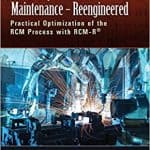
Even if you have excellent planning and scheduling, you may still experience excessive downtime. Some consultants will promise that you’ll save a great deal of money with good P&S simply because planned and scheduled work is less expensive to execute. They are partially right too! But that’s only part of the picture. That excessive downtime you are still experiencing has nothing to do with P&S skills and schedule compliance. In fact, even with good P&S, if you are doing the wrong proactive maintenance, then you will have difficulty achieving high levels of schedule compliance. You need to put the other piece of the puzzle in place – reliability – start doing the right maintenance.One of our clients (a major electric utility) had a very high level of schedule compliance to a maintenance program that was based almost entirely on manufacturers’ recommendations. Yet their costs for their maintenance program were high in comparison with other utilities. Despite the extensive proactive program, they still experienced too many unexpected failures. We applied Reliability Centered Maintenance and they discovered exactly what we thought they’d find – they were over maintaining, and moreover, some of that excessive maintenance was leading to premature failures (infant mortality).
If you need to increase the reliability and performance of your physical assets in the shortest time-frame possible, then you need an RCM-R® Reliability Expert from Conscious Asset. We will help you identify which asset or system puts the business at highest risk using our Asset Criticality Analysis, then help you conduct RCM-R® analyses. We can train your team to do analyses, carry out pilot projects to prove the concepts, train and mentor your facilitators, and help you manage the start up of your reliability program. Here’s how …
Start with training for your team – best delivered on-site, but you can also send them to our public courses. That’s the first step towards competence – learning the basics.
Once you have that basic understanding it is best to put it to practice soon. Carry out a pilot project on one of your least reliable assets. Pick a system that experiences excessive downtime, excessive maintenance costs, consumes too many of your lean staff resources. We do not shy away from a challenge – it is where RCM-R® shines brightest. In the process your analysts become certified, attesting to their qualifications (passing our course exam) and their newly gained experience – they earn their ORANGE belts.
Once we’ve proven the concept and given your team some experience, we know that you’ll want to use it on other critical assets. Within two weeks of your first RCM-R® training, you’ll already seen the benefit. You’ll want to decide on whether or not to train your own facilitators or depend on ours. We can help you determine which approach is most cost effective. In that brief analysis we consider the downtime you are experiencing and will continue to experience until your facilitators are trained and producing their own analyses.
Let’s assume that you opt to train your own facilitators, perhaps just a couple of them. We always recommend more than one because other companies may attempt to rob you of your trained facilitators. You don’t want to lose them. Their training in class takes just a few days, then we begin a mentoring process, taking them through a few initial analyses as they hone their facilitation and RCM-R® skills. Within a week to two weeks, you’ll have more completed analyses and their benefits. Your facilitators are usually competent by the end of two analyses and we prove that with our review of their first “solo” analysis. Successful candidates earn our RCM-R® BROWN BELT certification.
If you know anything about Reliability, then you’ll know it can get into some mathematics that few (usually engineers and very good technologists) can be comfortable with. Even they are unlikely to have any education in reliability math – it’s only taught at a few distinguished universities world-wide, and there, only at the Master’s level. But take heart – you don’t need to send someone on a Master’s degree program to handle the applied math that we teach in our Advanced Reliability course, earning our GREEN belt certification.
Rarely do end users of RCM-R®, or any other RCM methodology, want the ability in-house to train their own people. But experienced Brown belts, later in their careers, sometimes make their way into consulting. For those and others who wish to teach our methods and help customers implement reliability, we have our BLACK belt program.
Our instructors and consultants are all highly experienced BLACK belts.
Leave a Reply